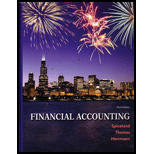
Requirement – 1
To calculate: The return on assets for both companies, and compare with given companies.
Requirement – 1
Explanation of Solution
Return on total Assets:
It is a measure to evaluate the efficiency of company’s assets. It reports the profit earned as the percentage of total assets used in the business. A company’s
The formula to compute return on asset:
The return on assets for both companies is as follows:
Company G:
Company Y:
Therefore, the return on assets of Company G and Company Y is 14.93% and 7.06% respectively.
Return on assets of Company G is lower than the Company A but higher than the Company D. Company Y has lower return on assets than Company A and Company D.
Working note:
Calculate the average total assets of Company G.
(1)
Calculate the average total assets of Company Y.
(2)
Requirement – 2
To calculate: The cash return on assets for both companies, and compare with given companies.
Requirement – 2
Explanation of Solution
Cash return on assets:
It refers to the rate of cash generated from the investments in assets of company. It is relationship between the
The formula to compute cash return on assets:
The cash return on assets for both companies is as follows:
Company G:
Company Y:
Therefore, the cash return on assets of Company G and Company Y is 22.34% and 8.91% respectively.
Cash return on assets of Company G is lower than the Company A but higher than the Company D. Company Y has lower cash return on assets than Company A and Company D.
Requirement – 3
To calculate: The cash flow to sales ratio and asset turnover ratio for both companies , and compare with given companies:
Requirement – 3
Explanation of Solution
Cash flows to sales:
It measures the cash generated from operating activities for each dollar of sales.
The formula to compute cash return on assets
Assets Turnover:
It’s a measure to evaluate the efficiency of total assets used in the business to generate sales during a certain period. Assets turnover reflects the net sales as the times of average total assets.
The formula to compute asset turnover
The cash flow to sales ratio and asset turnover ratio for both companies are as follows:
Cash flow to sales ratio:
Company G:
Company Y:
Assets Turnover:
Company G:
Company Y:
Therefore, the cash flow to sales ratio of Company G and Company Y is 38.43% and 26.57% respectively, and assets turnover ratio of Company G and Company Y is 0.58 and 0.34 respectively.
Cash flow to sales ratio of Company G and Company Y is similar to Company A and higher than the Company D, while assets turnover is lower than the Company A and Company D.
Want to see more full solutions like this?
Chapter 11 Solutions
Financial Accounting

 AccountingAccountingISBN:9781337272094Author:WARREN, Carl S., Reeve, James M., Duchac, Jonathan E.Publisher:Cengage Learning,
AccountingAccountingISBN:9781337272094Author:WARREN, Carl S., Reeve, James M., Duchac, Jonathan E.Publisher:Cengage Learning, Accounting Information SystemsAccountingISBN:9781337619202Author:Hall, James A.Publisher:Cengage Learning,
Accounting Information SystemsAccountingISBN:9781337619202Author:Hall, James A.Publisher:Cengage Learning, Horngren's Cost Accounting: A Managerial Emphasis...AccountingISBN:9780134475585Author:Srikant M. Datar, Madhav V. RajanPublisher:PEARSON
Horngren's Cost Accounting: A Managerial Emphasis...AccountingISBN:9780134475585Author:Srikant M. Datar, Madhav V. RajanPublisher:PEARSON Intermediate AccountingAccountingISBN:9781259722660Author:J. David Spiceland, Mark W. Nelson, Wayne M ThomasPublisher:McGraw-Hill Education
Intermediate AccountingAccountingISBN:9781259722660Author:J. David Spiceland, Mark W. Nelson, Wayne M ThomasPublisher:McGraw-Hill Education Financial and Managerial AccountingAccountingISBN:9781259726705Author:John J Wild, Ken W. Shaw, Barbara Chiappetta Fundamental Accounting PrinciplesPublisher:McGraw-Hill Education
Financial and Managerial AccountingAccountingISBN:9781259726705Author:John J Wild, Ken W. Shaw, Barbara Chiappetta Fundamental Accounting PrinciplesPublisher:McGraw-Hill Education





